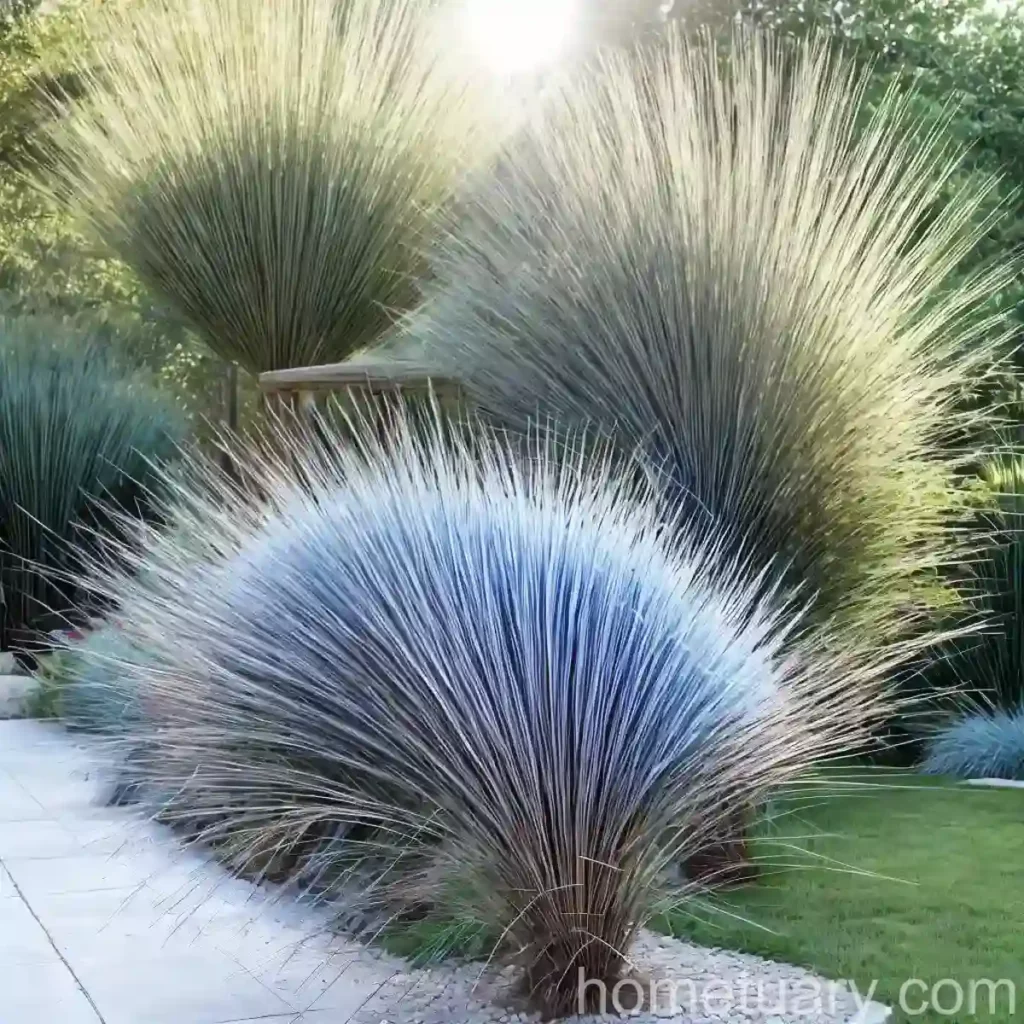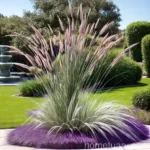The Magnificent big bluestem (Andropogon gerardii): A Complete Guide
big blue stem (Andropogon gerardii) is a tall and graceful prairie grass that is native to North America. This stunning plant is often used for landscaping, restoration projects, and as a habitat for wildlife. In this comprehensive guide, we will explore the culture, uses, care, and maintenance of big blue stem, also known as Andropogon gerardii. Furthermore, we will delve into its role in the ecosystem, common diseases, pests, and provide valuable tips for its cultivation. So, whether you are a seasoned gardener, a landscape enthusiast, or simply captivated by the beauty of native grass species, this guide will equip you with all the essential knowledge about big blue stem.
What is plant :big blue stem (Andropogon gerardii)?
Big bluestem, scientifically known as Andropogon gerardii, is a warm-season, perennial grass that belongs to the Poaceae family. It is commonly referred to by various other names, including tall prairie grass, bluejoint grass, and prairie cordgrass. This native grass species can be identified by its stunning blue-green foliage, and its upright, clump-forming growth habit. With its ability to reach heights of up to 6-8 feet, big bluestem is a prominent feature of the tallgrass prairie ecosystem.
Key Takeaways – big blue stem (Andropogon gerardii)
Before we embark on a detailed exploration of big bluestem, let’s overview the key takeaways about this remarkable plant:
- Native Grass Species: big blue stem is a native grass species to North America, specifically thriving in the tallgrass prairies of the Midwest.
- Ornamental Prairie Grass: It is prized for its ornamental value and has become a popular choice for landscaping and restoration projects.
- Drought-Tolerant: Known for its exceptional drought tolerance, big bluestem is an ideal choice for xeriscaping and water-wise gardening.
- Wildlife Habitat Plant: This tall grass plays a crucial role in providing food and habitat for various wildlife species, including birds and insects.
- Erosion Control and Soil Stabilization: With its deep, robust root system, big bluestem contributes to soil stabilization and erosion control in ecological restoration projects.
With these key points in mind, let’s delve into the specifics of cultivating and caring for big blue stem, covering its cultural requirements, uses, and essential maintenance practices.
Culture
The successful cultivation of big blue stem relies on understanding its cultural requirements, including water, sunlight, soil, and fertilization needs.
Water
Big bluestem is renowned for its exceptional drought tolerance, making it an ideal choice for regions with low rainfall and hot summers. Although it can thrive in dry conditions once established, regular watering is essential during its initial growth phase. As a general guideline, provide 1 inch of water per week during the growing season, adjusting based on local climate conditions and soil moisture levels.
Sunlight
As a warm-season grass, big bluestem thrives in full sunlight. It requires at least 6-8 hours of direct sunlight daily to support robust growth and the development of its characteristic blue-green foliage. When selecting a planting site, ensure it receives ample sunlight throughout the day to promote the healthy and vigorous growth of big blue stem.
Fertilizer
big blue stem is well-adapted to nutrient-poor soils, and excessive fertilization can lead to an imbalance in its growth. Therefore, minimal to no fertilization is recommended for established big bluestem plants. However, if the soil is severely nutrient-deprived, a light application of a balanced, slow-release fertilizer in spring can help support healthy growth. Always conduct a soil test before applying any fertilizers to ensure they are necessary.
Soil
This native grass species is highly adaptable when it comes to soil types, thriving in a range of soil conditions, including loamy, sandy, or clay soils. It is well-suited to well-draining soils but can tolerate periodic wet conditions. Before planting, it’s advisable to work the soil to a depth of 6-8 inches to promote good root establishment. Additionally, maintaining a slightly acidic to neutral soil pH ranging from 6.0 to 7.0 is ideal for optimal growth and development.
Pruning
big blue stem is a low-maintenance grass, with minimal pruning requirements. In late winter or early spring, it is beneficial to cut back the previous year’s growth to a height of 4-6 inches to facilitate new growth and maintain an attractive appearance. This rejuvenation pruning helps remove any dead or damaged stems, allowing the plant to thrive during the growing season.
Propagation
Propagation of big bluestem can be achieved through several methods, including seed propagation and division.
Seed Propagation
Propagation from seeds is a common and effective method for establishing big blue stem in the landscape. To promote successful germination, seeds can be sown directly into the prepared soil in late fall or early spring. However, it’s essential to prepare the site by removing any existing vegetation and loosening the soil to facilitate good seed-to-soil contact. Keep the soil consistently moist until the seeds germinate, which typically occurs within 14-21 days.
Division
Dividing mature big bluestem clumps is another viable method of propagation. This process involves carefully digging up the plant and dividing the clump into smaller sections, ensuring each division has a healthy balance of roots and shoots. Replant the divisions at the appropriate spacing, and provide adequate moisture to support their establishment.
Container Popularity
Due to its stunning ornamental value and adaptability, big blue stem has gained popularity as a container plant. When grown in containers, it serves as an excellent choice for adding height, texture, and visual interest to patios, balconies, and gardens with limited space. Select large, sturdy containers that provide ample room for root development, and ensure they have drainage holes to prevent waterlogging.
Container
| Container Size | Soil Type | Watering | Sunlight | Fertilization |
|---|---|---|---|---|
| Large containers with a minimum depth of 18 inches | Well-draining potting mix | Regular watering to keep the soil consistently moist | Full sunlight | Minimal fertilization; use a balanced, slow-release fertilizer in spring if soil is nutrient-deprived |
Common Diseases
Understanding the common diseases that affect big blue stem is essential for its successful cultivation and maintenance.
Disease Diagnosis
While big bluestem is known for its resilience to most diseases, it can occasionally be susceptible to fungal diseases such as rust and leaf spot. Rust diseases are characterized by the appearance of orange to reddish-brown pustules on the leaves, while leaf spot diseases cause dark, irregularly-shaped lesions on the foliage.
Proper plant care such as providing adequate air circulation, avoiding overhead watering, and removing any affected plant material can aid in preventing and managing these diseases. Fungicidal treatments may be necessary in severe cases, but cultural practices are often effective in minimizing disease incidence.
Common Pests
Big bluestem is relatively resistant to pest infestations, but it may occasionally encounter certain pests that can affect its overall health.
Botanist’s Tips
To keep big blue stem healthy and vibrant, consider the following tips and recommendations:
- Native Landscaping: Incorporate big bluestem into native landscaping projects and restoration efforts to support local biodiversity and ecological diversity.
- Wildlife Gardens: Utilize big blue stem in wildlife gardens to attract and provide habitat for various bird species and beneficial insects.
- Erosion Control: Leverage the robust root system of big bluestem to stabilize soil and prevent erosion in landscapes and restoration sites.
Fun Facts
- Big bluestem is one of the dominant grass species of the North American tallgrass prairie, where it contributes to the diverse and thriving ecosystem.
- The name “big bluestem” is derived from the bluish coloration at the base of the stems that is particularly evident in the early stages of growth.
- The mature stems of big blue stem can turn a reddish-bronze color in the fall, adding a captivating seasonal interest to the landscape.
Links to External Resources
For further information on big blue stem (Andropogon gerardii), refer to the following external resources:
- University of Missouri Extension – “big bluestem”
- Lady Bird Johnson Wildflower Center – “Andropogon gerardii”
- United States Department of Agriculture – “Plant Guide: big bluestem”
- North Carolina State University Extension – “Ornamental Grasses”
By integrating the insights and recommendations provided in this comprehensive guide, you can confidently cultivate, nurture, and appreciate the splendid qualities of big blue stem in your landscape, restoration, or native planting projects. With its remarkable ornamental appeal, ecological benefits, and low-maintenance nature, big blue stem stands as an exceptional native grass species that continues to enrich and enliven natural and designed landscapes alike.















